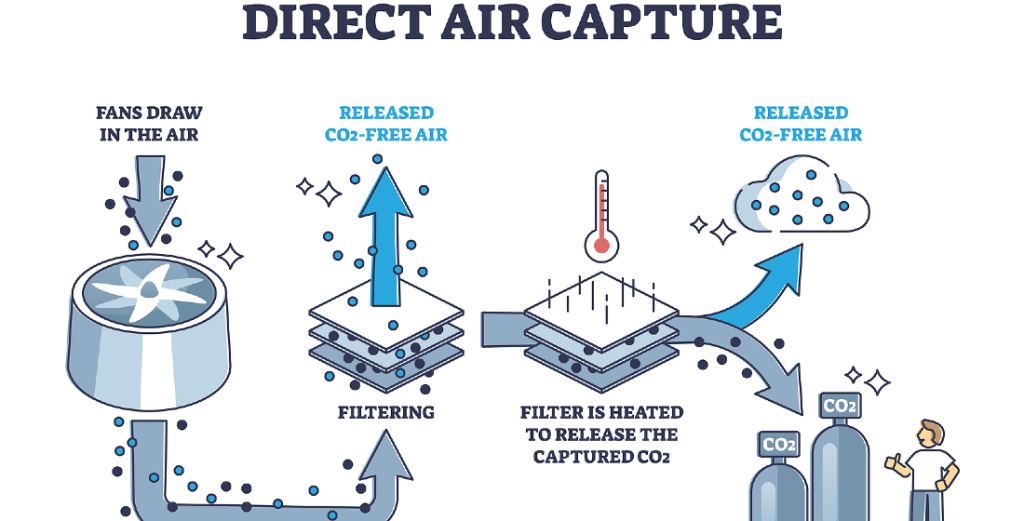
What is Direct Air Capture?
Direct Air Capture (DAC) is an emerging technology aimed at reducing atmospheric CO2 levels, helping to mitigate climate change. Unlike traditional methods that capture CO2 at the source (like factories), DAC pulls CO2 directly from the ambient air. This process involves large fans that draw in air, which is then passed through chemical solutions or solid filters that capture CO2.
Direct Air Capture (DAC) is a technology designed to extract carbon dioxide (CO2) directly from the air using chemical reactions. When air passes over specific chemicals, they selectively bind with CO2, while the rest of the air’s components are left untouched. Leading DAC systems utilize either liquid solvents or solid sorbents—chemicals already used in everyday products like soap and water filters. After CO2 is captured, heat is usually applied to release it from the chemicals, allowing them to be reused in another capture cycle. Some emerging systems explore electrochemical methods to lower energy use and costs. DAC’s potential is significant because it can theoretically capture CO2 from any location on Earth, making it a versatile tool in the fight against climate change. However, several challenges come with this technology.
Here is a video from WRI, which explains this in more details
Direct Air Capture (DAC) has gained significant attention and investment recently, driven by the recognition that carbon removal is crucial for meeting climate goals. DAC is appealing due to its scalability, minimal land use, and flexible siting. Leading companies like Climeworks, Carbon Engineering, and Global Thermostat have developed 18 plants capturing nearly 8,000 tons of CO2 annually, with half permanently sequestered. A larger plant with a million-ton capacity is expected in 2024. While DAC is still in the prototype phase, there is significant potential for improving its performance and reducing costs.
Resource Considerations:
- Energy Demand: DAC is energy-intensive, requiring substantial electricity to operate the fans, pumps, and processes that capture CO2. If this energy comes from fossil fuels, it could negate the environmental benefits of DAC. Therefore, the technology must be powered by renewable energy to be truly effective.
- Water Usage: Some DAC methods require significant amounts of water, particularly when using chemical solutions to capture CO2. This could be problematic in water-scarce regions.
- Land Use: Large-scale DAC facilities require considerable land, potentially competing with other land uses, such as agriculture or conservation.
Status of Leading DAC companies
Exhibit: Summary of leading DAC companies (Source: World Resource Institute, ADI Analytics)
Costs of Carbon Removal:
- Economic Feasibility: Currently, DAC is more expensive than other carbon removal methods, with costs ranging from $100 to $600 per ton of CO2 removed. The price is expected to decrease with technological advancements and economies of scale, but it’s still a significant barrier.
- Market Demand: The market for captured CO2 is limited, primarily used in enhanced oil recovery or carbonated beverages. Expanding markets, such as synthetic fuels, could improve the economic viability of DAC.
Conclusion:
Direct Air Capture is a promising but challenging technology. Its success in combating climate change will depend on overcoming significant technical and economic hurdles. Widespread deployment will require advances in renewable energy, reductions in costs, and the development of markets for captured CO2.




Leave a Reply